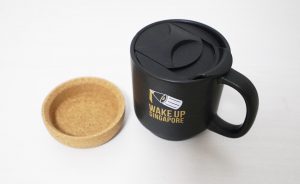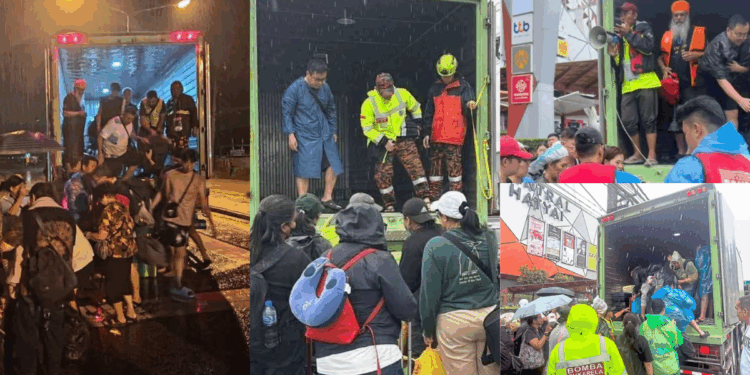A Disaster Zone and a Sudden Surge of Calls for Help
Southern Thailand’s floods escalated rapidly after days of intense rainfall, with Hat Yai recording its heaviest single-day downpour in three centuries on Friday, 21 November. Floodwaters rose to as high as 2m in parts of Songkhla province, leaving about 150,000 people stranded and cutting off entire areas from help.
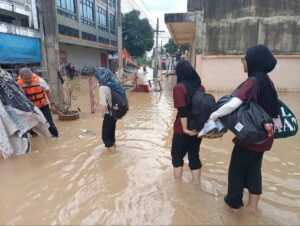
As emergency lines were overwhelmed — thousands pleading for evacuation, food, and drinking water — Thailand’s cabinet declared Songkhla a disaster zone. The military deployed reinforcements, including a C-130 transport plane, rubber boats, and the aircraft carrier Chakri Naruebet, equipped with helicopters, doctors, and field kitchens.
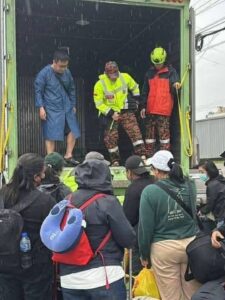
Posts from desperate Malaysians and locals flooded rescue group pages. Some had water reaching their second floors. Others said they were surviving without rice, water, or even phone reception.
Cross-Border Rescue Efforts Begin (Nov 21–23)
By Nov 21, Malaysia’s Fire Squads (PBS) — 45 personnel from 13 teams across Kedah, Penang, Perak, Selangor, and Johor — began a cross-border humanitarian mission in Hat Yai. The Ministry of Housing and Local Government later praised their commitment, saying their deployment of rescue boats, 4WDs and logistics trucks helped create an orderly, professional response on the ground.
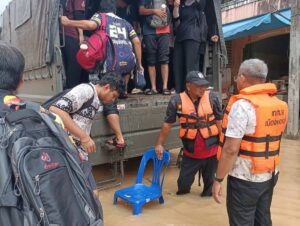
United Sikhs Malaysia also mobilised at the same time, transporting food, medical assistance and logistical support to stranded Malaysians. Their volunteers moved through rising waters and inaccessible roads to reach hotels where tourists were trapped.
Thousands of Malaysians Evacuated (Nov 23–27)
Prime Minister Anwar Ibrahim announced that more than 6,000 stranded Malaysians had been rescued and brought home since the operation began on Sunday, 23 November. The coordinated effort involved nearly 20 Malaysian volunteer organisations, with support from Wisma Putra, Thai authorities, and local rescue teams.
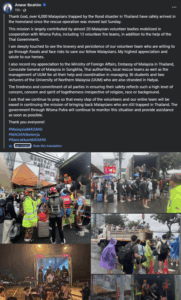
Among those evacuated were 36 Universiti Utara Malaysia students and two lecturers. Across Hat Yai, volunteers reported scenes of chaos — no electricity, no water, and many surviving by collecting rainwater just to drink.
Anwar said he was “deeply moved” by the courage of the rescue teams who “braved the floods and faced risks” to save fellow Malaysians. He urged the public to pray for remaining teams still working on the ground.
United Sikhs Lose a Boat but Continue Rescuing (Nov 26–28)
On Wednesday, 26 November, United Sikhs Malaysia volunteers hit a sharp object during a rescue run, causing their boat to capsize. All passengers were wearing life jackets and were unharmed. By the next day, they secured a new boat and resumed operations.
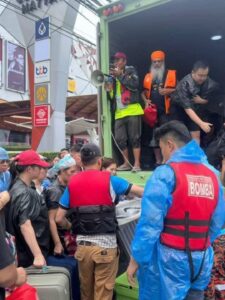
Their volunteers continued evacuations from severely flooded hotels, where toilets were clogged and conditions were “stinking and very unpleasant.” Three volunteers remained stranded overnight in a hotel to accompany victims — their presence reassuring those still waiting for evacuation.
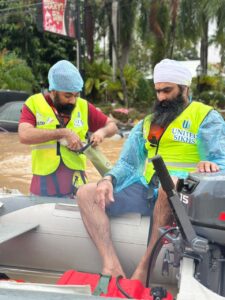
From Thursday morning until evening, 13 buses transported Malaysians to the border, while others left by private vans. United Sikhs president Sunil Shukvir Singh estimated that close to 1,000 people departed Hat Yai that day alone.
Floodwaters had begun to recede in most areas except one. Once that final area clears, Sunil said, four-wheel drives and army trucks would be able to reach those still stuck — ensuring at the very least access to food and clean water.
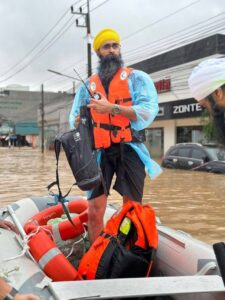
The team also reported a brief break in the weather: “Today we have sunshine, though clouds remain. We are still cautious about a potential third wave.”
A Mission Powered by Volunteers
United Sikhs has been on the ground since Sunday, rescuing hundreds of Malaysians.
PBS teams have been working since 21 November, backed by KPKT and supported by United Sikh Seri Muda’s logistics, medical units and food aid.
Despite capsized boats, blocked roads, and worsening hotel conditions, both volunteer groups have pushed through exhaustion to keep the evacuation routes open.
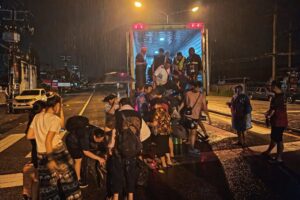
As of 28 November, stranded Malaysians continue returning home in stages — a relief made possible by a volunteer operation that has been running non-stop across borders, across communities, and across rising floodwaters.
United Sikhs Malaysia and Malaysia’s PBS have been rescuing stranded Malaysians in Hat Yai since the floods began, with teams battling deep waters, blocked roads and overwhelmed emergency lines.
More than 6,000 people have already been evacuated as volunteers continue cross-border missions despite capsized boats and worsening conditions.
Watch videos here:
@nrfrhna888 Siapa masih di Area MAYFLOWER GRANDE HATYAI. Korang boleh redah, air da surut paras betis, terus ke central hatyai bantuan Malaysia ade kat sana. Jangan tunggu lagi!
@nrfrhna888 Lobby da surut. Minta bantuan pickup kami!
More from Wake Up Singapore:-
Floods Hit Johor with Over 1,600 Evacuated Across Four Districts
Children Ride Plastic Raft as Motorbike Tows Them Through Flooded Neighbourhood
‘Survivors Escaped with Nothing’: Sudden Cloudbursts Claim Hundreds of Lives in Northern Pakistan
If you have a story or a tip-off, email admin@wakeup.sg or get in touch via Whatsapp at 8882 5913.
Interested in advertising on our media channels? Reach out to us at admin@wakeup.sg!
Since you have made it to the end of the article, follow Wake Up Singapore on Telegram and X!
Wake Up Singapore is a volunteer-run site that covers alternative views in Singapore. If you want to volunteer with us, sign up here!
If you can, please do consider buying a mug or two to support Wake Up Singapore’s work!

